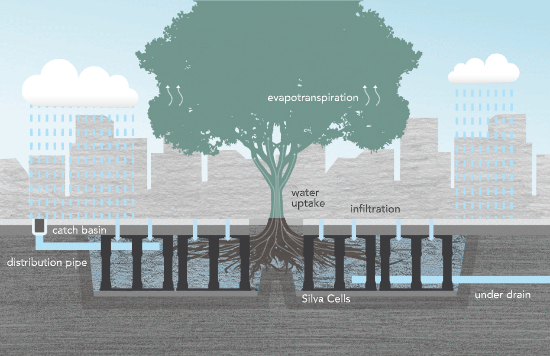
Natural forests are incredibly efficient stormwater management systems. Trees have an innate ability to intercept, infiltrate, and store rainwater with their broad canopies, extensive roots, and complex vascular systems. Additionally, forest floors literally soak up stormwater like a giant sponge. These qualities should not be underestimated. Stormwater managers often look for ways to utilize these services in the urban environment.
Urban areas, as one might expect, behave quite differently compared to natural forests. Unfortunately, challenges abound when it comes to realizing the full suite of stormwater services trees can offer most cityscapes. Cityscapes are locations often in most desperate need of these services. Buildings, roads, and other infrastructure can lead to widespread soil compaction, space limitations, and other stressors like pollution. These stressors can negatively impact the overall health of urban trees. Fortunately, landscape architects and city planners have a few tools available to them that not only allow trees to survive urban landscapes, they allow them to thrive.
Urban areas are highly altered landscapes often resulting in less than ideal growing conditions. The biggest limiting factor for tree success in the urban environment is poor soil conditions. With the help of best management practices (BMPs) like structural cells and rock-based structural soil, however, urban areas can support trees that reach their full stormwater management potential.
Structural Cells (a.k.a. Suspended Pavement)
Structural cells are constructed using a latticework of modular (often rigid plastic) support structures buried underground upon which sidewalks and bioretention facilities are built. These support structures bear the weight of overlying pavement, effectively suspending it above the soil beneath. Structural cells can be backfilled with fluffy, uncompacted planting medium which allows tree roots and stormwater to penetrate otherwise impervious areas.
Rock-based Structural Soil
In a similar method, rock-based structural soil can be installed in bioretention structures between city streets and sidewalks. Structural soil is an engineered medium comprised of angular gravel with consistent particle sizes in the 1 ½ - 2 inch range mixed with about 20% loam soil. The size and shape of gravel used in a structural soil provides plenty of voids in which tree roots can expand even when compacted. The extensive pore space in a structural soil also allows for stormwater infiltration and storage, while at the same time, meeting load capacity standards required by most engineering designs.
The next time you take a stroll around the town, take a moment to observe not only the aesthetic beauty of your urban forest, but also appreciate the many services healthy trees can provide to our communities.



